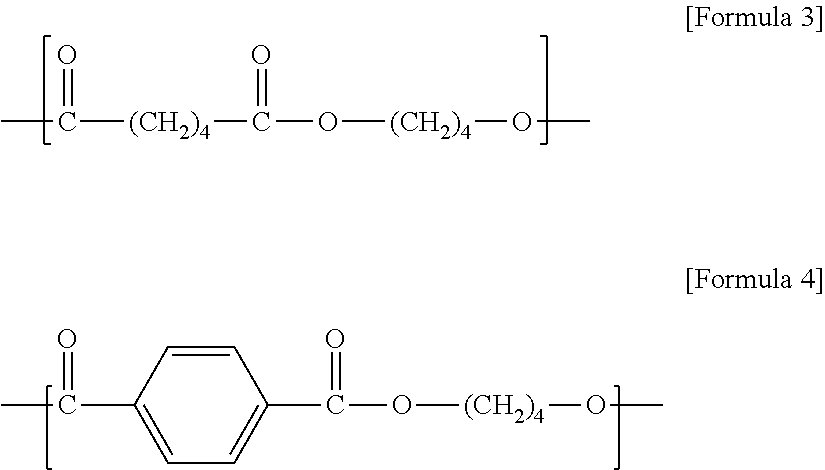Method for continuous production of biodegradable aliphatic/aromatic polyester copolymer
a technology of aromatic polyester and aliphatic, which is applied in the field of continuous preparation can solve the problems of reducing the hydrolysis rate of biodegradable polyester, affecting the quality of the product, so as to reduce the manufacturing cost of biodegradable aliphatic/aromatic polyester copolymer, the effect of suppressing side reactions
- Summary
- Abstract
- Description
- Claims
- Application Information
AI Technical Summary
Benefits of technology
Problems solved by technology
Method used
Image
Examples
example 1
Preparation of Biodegradable poly(butylene adipate-co-terephthalate) (PBAT)
[0124][First Slurry Tank]
[0125]1,4-butanediol and adipic acid were put into a first slurry tank in a molar ratio of 1.3:0.52, stirred at a temperature of 70° C., and mixed to prepare a slurry.
[0126][First Esterification Reaction]
[0127]The slurry from the first slurry tank was continuously put into a first esterification reactor for first esterification reaction of 1,4-butanediol and adipic acid. The flow rate was about 35 kg / h, the reaction temperature was 180° C., and the pressure was normal.
[0128]A vertical-type reactor equipped with a stirrer having pitched paddle impellers (manufactured by Hado, Ltd., Korea) was used as the first esterification reactor for the first esterification reaction (refer to http: / / www.hado.co.kr / default1.html). Triphenyl phosphate and tetra-n-butyl titanate were added into a reaction mixture in the first esterification reactor.
[0129]Triphenyl phosphate and tetra-n-butyl titanate ...
example 2
Preparation of Biodegradable PBAT
[0155][First Esterification Reaction]
[0156]1,4-butanediol and adipic acid were put into a batch reactor in a molar ratio of 1.3:0.52, followed by esterification reaction at a temperature of 180° C. at an atmospheric pressure to obtain bishydroxy butylene adipate (hereinafter, referred to as BHBA), which was stored in a storage tank.
[0157]Water produced from the first esterification reaction was removed through a condenser, followed by continuously adding triphenyl phosphate and tetra-n-butyl titanate into a batch reactor for esterification reaction of 1,4-butanediol with adipic acid. Triphenyl phosphate and tetra-n-butyl titanate were each pre-mixed with 1,4-butanediol to a concentration of 10% by weight prior to the continuous adding into the batch reactor. The amounts of triphenyl phosphate and tetra-n-butyl titanate were about 0.1 g and about 0.3 g, respectively, each per 0.52 mol of adipic acid.
[0158]The reaction product from the first esterifica...
example 3
Preparation of Biodegradable PBAT
[0177][First Slurry Tank]
[0178]1,4-butanediol, adipic acid, and terephthalic acid were put into the first slurry tank in a molar ratio of 1.3:0.52:0.48, stirred and mixed together at a temperature of 60° C. to prepare a slurry.
[0179][First Esterification]
[0180]The slurry from the first slurry tank was continuously put into the first esterification reactor for first esterification reaction. The flow rate of the slurry was 48 kg / h, the reaction temperature was 180° C., and the pressure was normal.
[0181]Triphenyl phosphate and tetra-n-butyl titanate were added into the reaction mixture in the first esterification reactor to perform esterification reaction.
[0182]Triphenyl phosphate and tetra-n-butyl titanate were each pre-mixed with 1,4-butanediol to a concentration of 10% by weight, and were continuously added into the first esterification reactor. The flow rate of the reaction mixture was adjusted to use 0.1 g (2.94×10−4 mol) of tetra-n-butyl titanate ...
PUM
| Property | Measurement | Unit |
|---|---|---|
| temperature | aaaaa | aaaaa |
| temperature | aaaaa | aaaaa |
| temperature | aaaaa | aaaaa |
Abstract
Description
Claims
Application Information
 Login to View More
Login to View More - R&D
- Intellectual Property
- Life Sciences
- Materials
- Tech Scout
- Unparalleled Data Quality
- Higher Quality Content
- 60% Fewer Hallucinations
Browse by: Latest US Patents, China's latest patents, Technical Efficacy Thesaurus, Application Domain, Technology Topic, Popular Technical Reports.
© 2025 PatSnap. All rights reserved.Legal|Privacy policy|Modern Slavery Act Transparency Statement|Sitemap|About US| Contact US: help@patsnap.com



